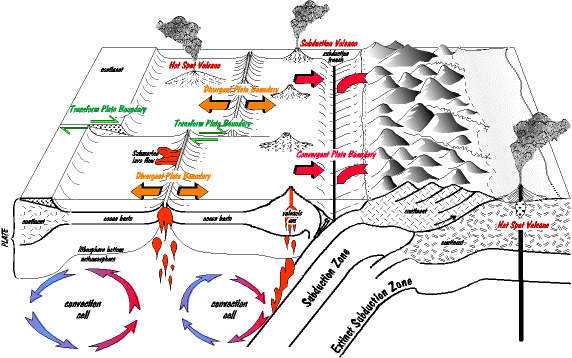Sea Floor Spreading And Subduction Zones Worksheet Answers

Refer back to the demonstration that you performed during the engage portion of the lesson to demonstrate this.
Sea floor spreading and subduction zones worksheet answers. As years pass lateral segments of seafloor will thus share the same signature on either side of the mid oceanic ridge. As magma flows out of the ridge the newly formed crust pushes older crust away from the ridge. While new earth is being born at mid ocean ridges by seafloor spreading in other areas earth is being destroyed at deep ocean trenches by subduction. Subduction is the process by which the ocean floor sinks beneath a deep ocean trench and back into the mantle.
Review answers to the seafloor structure handout by filling in the diagrams on board or using smartboard. Subduction happens where tectonic plates crash into each other instead of spreading apart. You may use your book and whatever notes you have. At deep ocean trenches subduction allows part of the ocean floor to sink back into the mantle over tens of millions of years.
Seafloor spreading is just one part of plate tectonics. Then answer the questions below. Directions the diagram on the reverse side depicts an area of the ocean floor where different plates are shifting due to plate tectonics. A deep ocean trench forms where the oceanic crust bends downward.
The processes of subduction and sea floor spreading can change the size and shape of the oceans. Continue pulling the magma strips until the magma sticks slide across the ocean floor. By printing out this quiz and taking it with pen and paper creates for a good variation to only playing it online. Instead the ocean floor plunges into deep under water canyons called deep ocean trenches.
Begin by labeling the parts draw an arrow to indicate which feature you mean. Seafloor spreading is happening at b. The two processes of seafloor spreading and subduction work together to constantly recycle and renew the earth s crust. At subduction zones the edge of the denser plate subducts or slides beneath the less dense one.
Molten rock pushes up from the asthenosphere and pushes the plates apart at the mid ocean ridge. Students should change the model so that magma is pushed out of the ridge not pulled. Where there are deep ocean trenches subduction takes place. The denser lithospheric material then melts back into the earth s mantle.
The old crust gets pushed to the. The answer is that the ocean floor generally does not just keep spreading. This creates new ocean crust. Explain that seafloor spreading and movement is a cyclical process because it is constantly being created and destroyed.














































